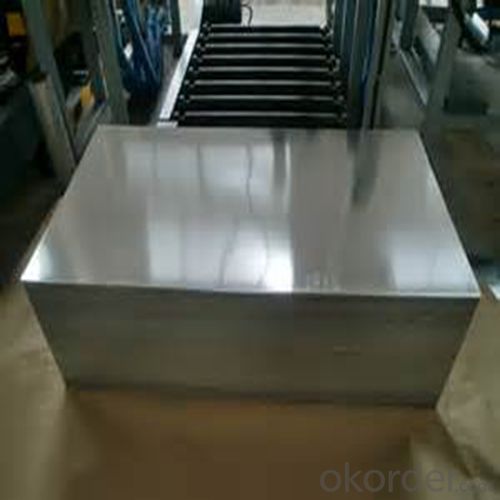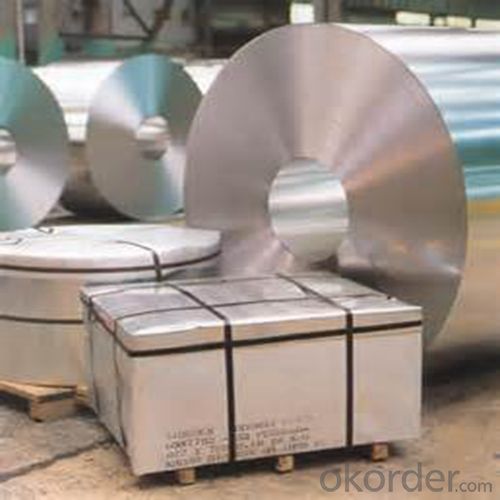Tinplate and TFS for Chemical or Industrial Useage
- Loading Port:
- Shanghai
- Payment Terms:
- TT OR LC
- Min Order Qty:
- 25 m.t.
- Supply Capability:
- 30000 m.t./month
OKorder Service Pledge
OKorder Financial Service
You Might Also Like
Item specifice
1.Structure of Tinplate and TFS for Chemical or Industrial Useage Description
Electrolytic Tinplate,is one thin steel sheet with a coating of tin applied by electrolytic deposition. Tinplate made by this process is essentially a sandwich in which the central core is strip steel. This core is cleaned in a pickling solution and then fed through tanks containing electrolyte, where tin is deposited on both sides. As the strip passes between high-frequency electric induction coils, it is heated so that the tin coating melts and flows to form a lustrous coat.
Also known as chromed steel, tin-free steel (TFS) is obtained by coating the metal base (low-carbon steel) with an ultra-thin layer of metallic chrome and then with a chromium oxide layer.
2.Main Features of the Tinplate and TFS for Chemical or Industrial Useage
Appearance – Tinplate is characterized by its beautiful metallic luster. Products with various kinds of surface roughness are produced by selecting the surface finish of the substrate steel sheet.
Paintability and printability – Tinplates have excellent paintability and printability. Printing is beautifully finished using various lacquers and inks.
Formability and strength – Tinplates have got very good formability and strength. By selecting a proper temper grade, appropriate formability is obtained for different applications as well as the required strength after forming.
Corrosion resistance – Tinplate has got good corrosion resistance. By selecting a proper coating weight, appropriate corrosion resistance is obtained against container contents. Coated items should meet 24 hour 5 % salt spray requirement.
3.Tinplate and TFS for Chemical or Industrial Useage Images



4.Tinplate and TFS for Chemical or Industrial Useage Specification
Specification of :
Standard: ISO 11949 -1995, GB/T2520-2000,JIS G3303,ASTM A623, BS EN 10202
Material: MR,SPCC
Thickness:0.15mm - 0.50mm
Width: 600mm -1150mm
Temper: T1-T5
Annealing: BA & CA
Coil Inner Diameter: 508mm
Weight: 6-10 tons/coil 1~1.7 tons/sheets bundle
Passivation:311
Oil: DOS
Surface: Finish,bright,stone,matte,silver
5.FAQ of Tinplate and TFS for Chemical or Industrial Useage
- How are the tinplates specified?
The tinplates are specified as per the steel base, extent of tempering, the coating weight, annealing method and the surface finish.
- How many types there are for base steels?
The base steels are of three types: Type MR, L, D
- Q:How does tinplate perform in terms of printability?
- Tinplate performs exceptionally well in terms of printability. Its smooth surface allows for high-quality printing with vibrant colors and fine details, making it a popular choice for packaging and labeling applications.
- Q:What are the different ways to stack tinplate cans?
- There are several different ways to stack tinplate cans, including vertically, horizontally, in a pyramid formation, or in a grid pattern. The choice of stacking method may depend on factors such as available space, stability required, or ease of access.
- Q:How does tinplate withstand corrosion?
- Tinplate withstands corrosion due to the protective properties of tin. The tin coating acts as a barrier between the underlying steel and the surrounding environment, preventing direct contact and oxidation. Tin has excellent corrosion resistance, even in humid and acidic conditions, making tinplate a reliable and durable material for various applications.
- Q:What are the common surface treatments for tinplate?
- The common surface treatments for tinplate include electrolytic tinplating, chromium plating, and passivation.
- Q:How does tinplate packaging contribute to product portion control?
- Tinplate packaging contributes to product portion control by providing a pre-determined size and shape for the product. The rigid structure of tinplate containers ensures that a specific quantity of the product is packaged, enabling consumers to easily manage their portions and avoid overconsumption.
- Q:What are the main differences between tinplate and tin-free steel?
- Tinplate is a thin steel sheet that is coated with a layer of tin, while tin-free steel is a type of steel that does not have a tin coating. The main difference between the two lies in their corrosion resistance and price. Tinplate offers excellent corrosion resistance due to its tin coating, making it ideal for packaging materials, such as food cans. On the other hand, tin-free steel may have lower corrosion resistance but is more affordable and commonly used in applications where corrosion resistance is not a primary concern, such as automotive parts or construction materials.
- Q:What are the common closure mechanisms for tinplate containers?
- The common closure mechanisms for tinplate containers include twist-off caps, press-on lids, and lever-lock lids.
- Q:How does tinplate packaging contribute to product protection against UV rays?
- Tinplate packaging does not contribute to product protection against UV rays.
- Q:How does tinplate compare to paperboard in terms of packaging applications?
- Tinplate and paperboard have different characteristics that make them suitable for different packaging applications. Tinplate is a durable and corrosion-resistant material that is commonly used for packaging products that require protection from moisture, air, and light, such as canned food and beverages. It offers excellent barrier properties and can be easily shaped into various forms, making it ideal for products that require a tight seal. On the other hand, paperboard is a versatile and cost-effective option for packaging applications. It is lightweight, recyclable, and biodegradable, making it environmentally friendly. Paperboard is commonly used for packaging dry goods, such as cereal boxes, cosmetics, and pharmaceuticals. It provides good printing capabilities, allowing for attractive and informative designs. In summary, tinplate is preferred for products that require strong protection and preservation, while paperboard is suitable for lightweight products that benefit from eco-friendly packaging options. The choice between the two materials depends on the specific needs of the product and its target market.
- Q:Can tinplate be soldered?
- Yes, tinplate can be soldered. Tinplate is a steel sheet coated with a layer of tin, which makes it suitable for soldering. The tin coating provides good solderability, allowing for the joining of tinplate using soldering techniques.
1. Manufacturer Overview |
|
|---|---|
| Location | |
| Year Established | |
| Annual Output Value | |
| Main Markets | |
| Company Certifications | |
2. Manufacturer Certificates |
|
|---|---|
| a) Certification Name | |
| Range | |
| Reference | |
| Validity Period | |
3. Manufacturer Capability |
|
|---|---|
| a)Trade Capacity | |
| Nearest Port | |
| Export Percentage | |
| No.of Employees in Trade Department | |
| Language Spoken: | |
| b)Factory Information | |
| Factory Size: | |
| No. of Production Lines | |
| Contract Manufacturing | |
| Product Price Range | |
Send your message to us
Tinplate and TFS for Chemical or Industrial Useage
- Loading Port:
- Shanghai
- Payment Terms:
- TT OR LC
- Min Order Qty:
- 25 m.t.
- Supply Capability:
- 30000 m.t./month
OKorder Service Pledge
OKorder Financial Service
Similar products
New products
Hot products
Related keywords



























